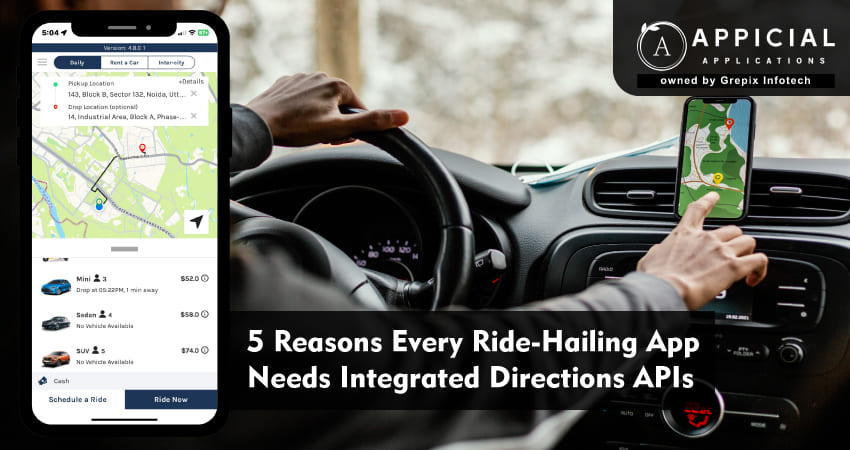
5 Reasons Every Ride-Hailing App Needs Integrated Directions APIs
In the fiercely competitive mobility services market, a ride-hailing app or ride-sharing app cannot rely solely on basic booking and matching. Many users expect seamless routing, accurate pickup and drop-off navigation, and timely travel estimates. Integrating a robust Directions API within your app architecture addresses those demands. When you build an Uber Clone or partner with a white label taxi app development company, this integration becomes a strategic necessity rather than an optional enhancement. Below, we present and examine five key reasons why any modern e-hailing app or white label taxi booking app must integrate directions APIs.
This article explains five strong reasons why every ride-sharing app, ride-hailing app, or e-hailing app must integrate Directions APIs. It explores how these APIs support real-time routing, cost-efficiency, driver and rider experience, data insights, and global scalability. It also details how a taxi app development company or white label taxi app development company can incorporate these features into an Uber Clone or white label taxi booking app. The conclusion promotes Appicial Applications as a partner for building advanced ride-hailing solutions, with a clear call to action (CTA).
Reason 1 Optimised Route Planning and Reduced Operational Costs
When your ride-hailing app integrates a mature Directions API, you enable real-time and historical traffic-aware route calculations between pickup and drop-off points. For example, one provider’s documentation emphasises that the Directions API “provides routable path(s) with traffic data considerations, thereby providing optimal path(s)” for transport services.
In a ride-sharing app or e-hailing app, optimised routing means fewer extra kilometres, less idle time for drivers, and improved fuel savings. If a taxi app development company builds this into your white label taxi booking app, you gain operational efficiency. When you build an Uber Clone, you reduce overheads associated with poor routing and excessive driver time.
Studies show that caching techniques to avoid repeated distance/ETA calculations can reduce API cost and latency. If you rely purely on raw calculations without optimisation, you incur higher technology and infrastructure costs. Therefore, for any serious taxi app development company, embedding route optimisation via Directions APIs is essential.
Moreover, the routing optimisation enables better driver-allocation logic. For instance, when the dispatch engine knows the optimal route ahead, it can dispatch the nearest driver while factoring in expected route time and traffic. This reduces “dead mileage” (driver travelling without a passenger) and enhances fleet utilisation.
Hence, if you are building a white label taxi booking app or an Uber Clone, ensuring that your directions module is integrated meaningfully contributes to both cost savings and better service quality.
Reason 2 Enhanced User Experience for Riders and Drivers
In a ride hailing app or e-hailing app, user experience (UX) is a major differentiator. Riders expect accurate arrival estimates, clear route visuals, and transparent journey details. Integration of a Directions API lets your ride-sharing app show turn-by-turn instructions, estimated travel time (ETA), and alternate route options. The documentation for a routing API indicates that “turn-by-turn instructions” is a core feature.
For a driver, having the route embedded inside your platform (rather than switching to third-party nav apps) avoids context switching and improves focus. A blog post by a provider described how a ride-hailing company saw a ~90 % drop in customer complaints after integrating their routing and location APIs.
When the driver's path and the rider’s pickup are precisely aligned, the perceived wait time drops. For your Uber Clone or white label taxi booking app, that translates into fewer missed pickups, fewer cancellations, and higher satisfaction.
Additionally, visual route previews for riders build trust: they can see exactly which path the driver is taking, which boosts transparency in your ride-hailing app or ride-sharing app. That trust drives repeat usage.
From the driver’s side, accurate routing promotes better planning, less wasted time, and fewer surprises. The ripple effect benefits your business: happier drivers, less attrition, and smoother operations.
Therefore, a taxi app development company building your platform must prioritise Directions API integration as a core UX investment.
Reason 3 Accurate ETAs, Pricing and Dispatch Efficiency
Accurate estimated time of arrival (ETA) and distance calculations are crucial in a ride hailing app or e-hailing app. If the rider is given a wrong ETA or the driver is unable to meet the ETA due to suboptimal routing, trust is eroded.
A Directions API provides distance and time data between origin and destination, accounting for traffic, waypoints and road restrictions. According to a developer guide, you can “calculate travel times and ETAs that account for real-time traffic” using modern routing APIs.
For your Uber Clone or white label taxi booking app, accuracy in ETA feeds directly into dispatch efficiencies. The dispatch engine assigns drivers more intelligently: it knows how long each ride will take, and can predict when drivers will become available for next bookings.
Additionally, pricing algorithms often depend on estimated distance/time. When your ride-sharing app uses inaccurate routing inputs, you risk under-charging or over-charging. With reliable Directions API data, your pricing model becomes tighter, which helps avoid losses and improves profitability for your taxi app development company deployment.
In short: Directions APIs are the backbone of smart dispatch, realistic ETAs and dynamic pricing. For any serious white label taxi app development company, this is a non-negotiable feature.
Reason 4 Scalability and Global-Readiness for Ride-Hailing Platforms
If you are developing an Uber Clone or planning to scale your ride-hailing app across cities or countries, you must deal with multiple geographies, road networks, traffic behaviours and mapping providers. Directions APIs from global platforms support multiple regions, numerous waypoints, traffic-aware routing and alternative routes. For example, one API supports up to 25 waypoints and multiple routing profiles (driving, walking, cycling) across geographies.
A ride-sharing app built for one city may work fine with a custom, simple routing engine. But when you expand into new markets, you need robust direction services that handle local road restrictions, real-time traffic, and varied profiles. A white label taxi booking app that partners with a taxi app development company must ensure the mapping infrastructure is robust, scalable and global.
Moreover, as your business grows, you will accumulate massive routing and traffic data. But the initial routing quality must be good globally. A mature Directions API relieves you of building your mapping infrastructure from scratch and gives you advanced features out of the box.
For a platform positioning itself as a serious player in the e-hailing app space, global readiness separates it from smaller local competitors. Therefore, any sensible taxi app development company will insist on Directions API integration early in the project.
Reason 5 Data Insights, Analytics and Continual Improvement
When your ride-hailing app uses a mature Directions API, you become privy to routing metadata: actual routes driven, deviations, segment durations, alternate route usage, and real-time traffic impact. This data becomes a rich source of insights for your ride-sharing app operations.
For example, by analysing route deviations, you can identify problem zones (e.g., frequent slowdowns, construction). You can adjust pricing, driver instructions or even dispatch logic accordingly. A blog on caching distance/ETA calculations noted how route-based insights are critical for optimisation.
In your white-label taxi booking app, this means you can implement real-time dashboards for driver productivity, route-time variation, and zone-based demand forecasting. A capable taxi app development company will build backend integrations to harvest and visualise this data.
Better data leads to better decisions: you may open new service zones, adjust surge logic, refine driver scheduling, optimise vehicle utilisation, and ultimately drive better margin.
Additionally, as you gather more routing history, you can refine your algorithms, adjust buffer times, and reduce cancellations. For a mature Uber Clone offering advanced service levels, this analytical edge is a differentiator.
What Should a Taxi App Development Company Consider When Integrating Directions APIs?
What features and considerations must be top-priority?
When you partner with a taxi app development company or engage a white label taxi app development company to build your ride-hailing app, the integration of Directions APIs must be planned carefully. Below are key features and considerations:
- API performance and latency: Routing must respond quickly to driver and rider requests. Choose APIs designed for high-volume, real-time routing. For example, one provider offers a “Directions Fast API” designed for high-volume, real-time scenarios.
- Traffic-aware and real-time updates: The routing engine must factor in live traffic and incidents; otherwise, ETAs become unreliable.
- Multiple waypoints and alternate routes: Allow for multi-stop bookings, pooling, or driver repositioning. Routing APIs support up to 25 waypoints.
- Global coverage and local nuances: A ride-hailing app planning growth must use routing APIs covering multiple geographies, road rules, toll data and localised routing.
- Integration into dispatch and matching engines: Routing should feed into your matching logic, driver availability, and route optimisation modules.
- Cost and usage monitoring: Routing API calls incur costs; caching frequently used routes and optimising calls is necessary.
- Failover and fallback mechanisms: If the primary routing API fails or latencies spike, backup logic must ensure service continuity.
- User-friendly UI/UX for route display: For riders and drivers, route visuals, ETAs and instructions must be integrated smoothly into your ride-sharing app interface.
- Compliance and terms of service: Many mapping/routing APIs have usage limits, pricing tiers, and licensing terms (e.g., the Google Routes API offers different pricing based on features).
When a competent white-label taxi app development company integrates these considerations, your Uber Clone or white-label taxi booking app will be well-positioned for reliability and performance.
What Are the Common Pitfalls to Avoid When Using Directions APIs?
Where do ride-hailing app developers often go wrong?
Even though integrating Directions APIs is highly beneficial, there are common mistakes in the implementation of a ride-hailing app or ride-sharing app. Recognising them up front helps a taxi app development company deliver a robust solution:
- Neglecting live traffic input: If routing ignores traffic, ETAs and driver assignments become unreliable.
- Over-dependence on external nav apps: Requiring drivers to switch out of your app for navigation reduces control and degrades experience.
- Ignoring caching and cost optimisation: Excessive API calls for popular routes increase costs unnecessarily.
- Poor UI for routing information: If riders and drivers cannot view or understand the route, or instructions are unclear, user trust suffers.
- Lack of failover strategy: If the routing service goes down or is slow, your e-hailing app must still service bookings; without a fallback, you risk service collapse.
- Incorrect pricing logic tied to distance/time: Using inaccurate routing data can lead to wrong fares, driver dissatisfaction or rider refunds.
- Limited global routing coverage: If your app expands to new cities but the routing API doesn’t properly support those geographies, you will face degraded service quality.
- Not incorporating analytics: If you treat the directions function as a pure nav module and ignore the data insights it produces, you miss a strategic lever.
A qualified white label taxi app development company will anticipate and address these pitfalls in your project scoping, ensuring your Uber Clone or ride-hailing app architecture is future-proof.
Also Read: The Role of Live Tracking in Building Rider Trust
How Does Integrating Directions APIs Fit into Your Uber Clone or White Label Taxi Booking App Strategy?
What steps should you follow when building your ride-hailing app?
When you decide to build a ride-sharing app, ride-hailing app, or e-hailing app, perhaps via a taxi app development company or white label taxi app development company, you should integrate Directions APIs as an early architectural decision. Here is a suggested breakdown:
- Requirement and use-case analysis: Define how routing will be used, including immediate bookings, scheduled rides, pooled rides, and driver repositioning.
- Select routing provider and API tier: Choose API vendor (e.g., Google Routes API, Mapbox Directions API) and pricing tier based on expected volume and features.
- Design dispatch and routing integration: Ensure routing data (distance, ETA, waypoints) feeds directly into the matching engine, driver allocation, and UI.
- UI/UX design for riders and drivers: Implement route visuals, pickup-to-drop profile, ETA display, and alternate route warnings.
- Backend data capture and analytics modules: Store routing metadata for insights and optimisation.
- Caching & cost-management strategy: Identify frequent routes (airport-city, frequent corridors) that can be cached to reduce API cost.
- Testing across geographies: Especially for a global e-hailing app, test routing in multiple cities, time zones, traffic conditions, and edge cases.
- Launch and monitor KPIs: Measure metrics like on-time pickup/driver arrival, distance/time variance, cancellation rates, driver idle time, and route inefficiencies.
- Continuous improvement: Use routing data to refine pricing, buffer times, surge zones, and driver deployment.
By treating Directions API integration as a foundational building block, your Uber Clone or white label taxi booking app will offer superior performance, reliability and scalability compared to apps that treat routing as an afterthought.
Why Partner with Appicial Applications for Your Ride-Hailing Platform?
When you build or scale a ride-hailing app, ride-sharing app, or e-hailing app, you need a partner that understands not just front-end UI, but also routing logic, dispatch optimisation, analytics and global scalability. That is where Appicial Applications stands out as your strategic partner.
Here is how Appicial Applications supports you:
- Full experience in building Uber Clone and white label taxi booking app solutions with integrated Directions APIs and routing modules.
- Deep expertise as a top-tier taxi app development company and white label taxi app development company, so you benefit from best practices, tested architecture and optimised workflows.
- Customisable modules covering driver matching, passenger UI, scheduling, route optimisation, real-time traffic, and analytics, all integrated with routing services.
- Global readiness: We help you select and integrate routing/Directions APIs that cover multiple geographies, enabling your ride-sharing app or ride-hailing app to scale internationally.
- Cost-effective architecture: We build caching layers, minimise redundant API calls, and optimise dispatch logic to reduce your operational overhead.
- UX-centric approach: We ensure that routing and directions are baked into the interface for riders and drivers, not just as add-ons, thus enhancing trust and retention.
- Post-launch analytics and optimisation: We help you monitor KPIs derived from routing data, refine your pricing and dispatch strategies, and evolve your e-hailing app intelligently.
Ready to build a next-generation ride-hailing platform that leverages integrated Directions APIs and global routing readiness? Contact Appicial Applications today for a free consultation and architectural review. Let us help you launch your Uber Clone or white label taxi booking app with superior routing, unmatched UX, and scalable operations.
Conclusion
In summary, integrating a robust Directions API is no longer optional for a credible ride-hailing app, ride-sharing app, or e-hailing app; it is fundamental. The five reasons discussed above, optimised routing and lower costs, enhanced user experience, accurate ETAs and pricing, scalability and global readiness, and data-driven analytics, clearly establish routing integration as a strategic imperative. If you ignore it, your platform risks falling behind in performance, satisfaction and reliability.
When you build your solution as an Uber Clone or via a white label taxi app development company, you must ensure routing and directions are core, not secondary. A partner like Appicial Applications can deliver this capability end-to-end, giving you a future-proof, high-performance platform.
Don’t wait until shortcomings in routing lead to cancellations, unhappy drivers or cost-overruns. Engage Appicial Applications now, and let’s create a ride-hailing platform tomorrow’s users will trust and choose.
FAQs
Author's Bio

Vinay Jain is the Founder at Grepix Infotech and brings over 12 years of entrepreneurial experience. His focus revolves around software & business development and customer satisfaction.
Back to blog list




